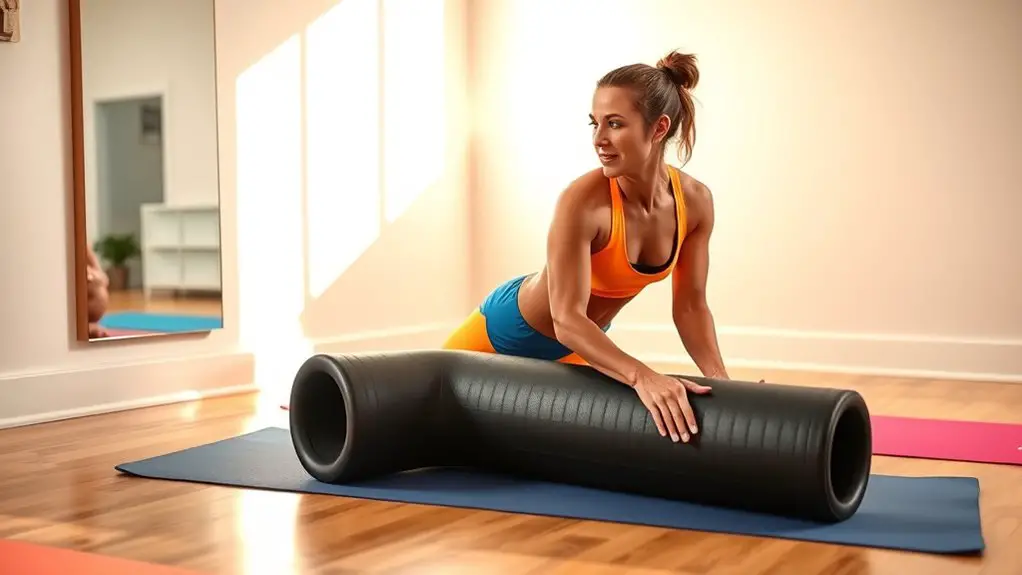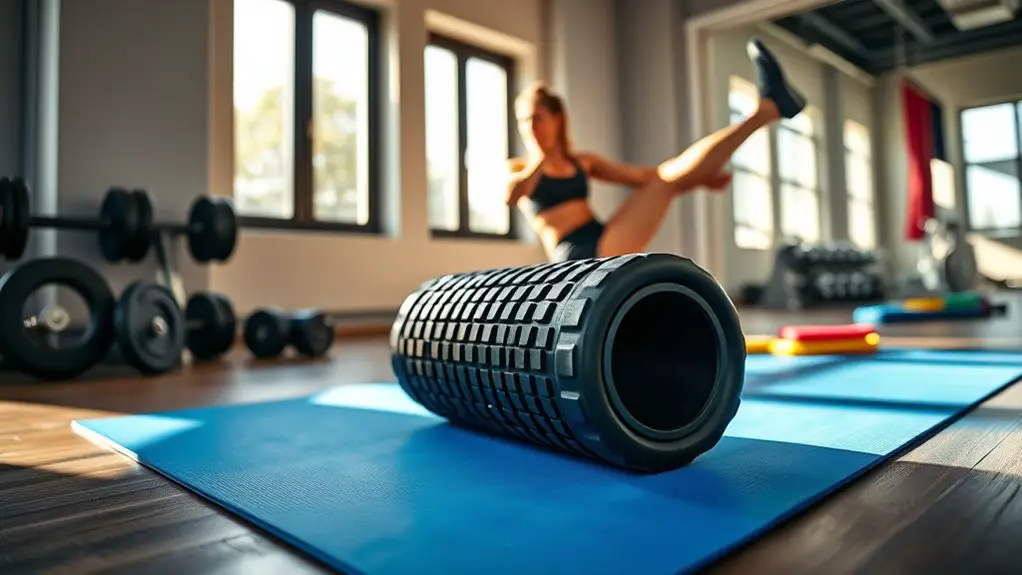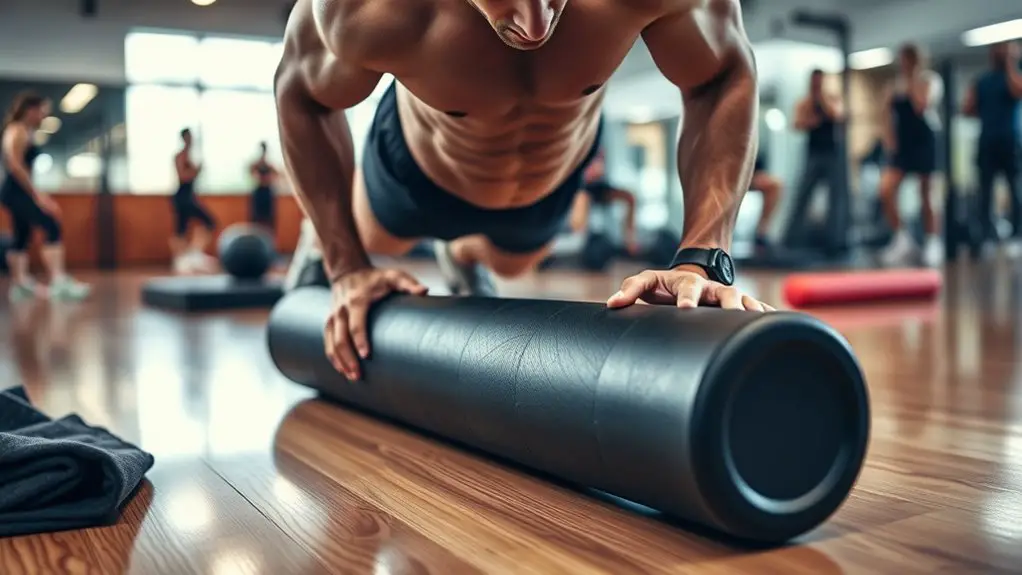The Role of Foam Rolling in Gym Recovery and Mobility

Foam rolling plays an important role in your gym recovery and mobility. It increases blood flow to your muscles, helping to reduce soreness and enhance flexibility. By releasing muscle tension and adhesions, foam rolling improves your range of motion and decreases the risk of injuries. Incorporating this technique into your routine can greatly aid your recovery process. Stick around to discover effective techniques and common mistakes to avoid for maximum benefits.
Understanding Foam Rolling: What It Is and How It Works

Foam rolling is a popular recovery technique that many gym-goers swear by, and for good reason. It involves using a foam roller to apply pressure to specific muscle groups, helping to release tension and improve mobility. When you roll over tight spots, you’re fundamentally performing self-myofascial release, which can enhance blood flow and reduce muscle soreness.
There are various foam rolling techniques you can try, such as rolling slowly over a muscle, pausing on tender spots, or using different angles to target specific areas. However, it’s crucial to separate fact from fiction, as foam rolling myths abound. Some believe that foam rolling is painful or that it’s only necessary after intense workouts; this isn’t true. Incorporating foam rolling into your routine can be beneficial regardless of your activity level or workout intensity. So, grab that foam roller and start reaping the benefits!
The Science Behind Foam Rolling and Muscle Recovery
While many people enjoy foam rolling for its immediate relief, the science behind it reveals deeper benefits for muscle recovery. This technique not only helps alleviate muscle soreness but also enhances your overall recovery timeline. Here’s how foam rolling contributes to effective muscle recovery:
Foam rolling offers immediate relief while promoting deeper muscle recovery and enhancing your overall recovery timeline.
- Increases blood flow: Improved circulation helps deliver nutrients and oxygen to muscles, promoting healing.
- Reduces adhesions: By breaking down knots and tight spots, foam rolling enhances muscle elasticity and function.
- Activates the nervous system: It can stimulate muscle receptors, improving muscle response and coordination.
- Decreases inflammation: Regular foam rolling may help reduce inflammation, speeding up recovery after intense workouts.
Incorporating foam rolling into your routine can greatly affect how quickly you bounce back from workouts, making it a valuable tool for anyone serious about their fitness journey.
Benefits of Foam Rolling for Flexibility and Mobility

Foam rolling can notably enhance your muscle elasticity, making it easier for you to move freely. By incorporating this technique into your routine, you’ll likely notice an improved range of motion, which can boost your overall performance. Whether you’re hitting the gym or just trying to stay active, foam rolling is a game changer for flexibility and mobility.
Enhanced Muscle Elasticity
Enhanced muscle elasticity is one of the standout benefits of incorporating foam rolling into your recovery routine. By effectively reducing muscle tension, foam rolling not only helps you feel better but also enhances your overall mobility. Here’s how it contributes to your flexibility:
- Encourages blood flow, delivering nutrients to your muscles
- Breaks down adhesions and scar tissue, improving muscle function
- Enhances muscle elasticity, allowing for smoother movements
- Supports faster recovery benefits, so you can get back to training sooner
Improved Range of Motion
When you incorporate foam rolling into your routine, you’ll likely notice a significant improvement in your range of motion. This enhanced flexibility is essential for both daily activities and athletic performance. Foam rolling helps release tension in tight muscles, which can restrict joint mobility. By breaking down adhesions and promoting blood flow, it complements dynamic stretching, allowing your muscles to relax and lengthen effectively. As a result, you’ll find it easier to achieve deeper stretches and more fluid movements during workouts. Regularly using a foam roller can lead to increased joint mobility, making your body more resilient and reducing the risk of injuries. Embrace foam rolling to unleash your full potential and elevate your fitness journey.
How Foam Rolling Can Prevent Injuries
Incorporating foam rolling into your recovery routine can greatly reduce the risk of injuries, as it helps maintain muscle flexibility and improves circulation. By using foam rolling as one of your injury prevention strategies, you can experience several foam rolling benefits that contribute to your overall performance.
Incorporating foam rolling into your recovery routine enhances flexibility and circulation, significantly reducing injury risk.
- Enhances blood flow to muscles, promoting quicker recovery
- Reduces muscle tightness, allowing for better movement mechanics
- Diminishes soreness post-workout, which can lead to overcompensation injuries
- Improves neuromuscular efficiency, helping you engage the right muscles during workouts
When you prioritize foam rolling, you’re not just alleviating discomfort; you’re proactively protecting your body from potential injuries. Consistent practice can lead to long-term improvements in flexibility and performance, making it an essential part of your fitness routine. Embrace foam rolling, and you’ll boost your training effectiveness while minimizing the risk of setbacks.
Techniques for Effective Foam Rolling

To get the most out of foam rolling, it’s important to target specific muscle groups effectively. You’ll want to use different rolling techniques to address tight areas and improve your recovery. Let’s explore how to maximize your foam rolling sessions for best results.
Target Muscle Groups
While foam rolling can seem straightforward, targeting specific muscle groups effectively requires a bit of technique. Different foam roller types can help you focus on various areas, enhancing your recovery and mobility. Here are some key muscle groups to target:
- Quadriceps: Roll from hip to knee to release tightness.
- Hamstrings: Focus on the back of your thighs, adjusting pressure as needed.
- Glutes: Sit on the roller and cross one leg over the other to target tight areas.
- Upper Back: Use the roller vertically to relieve tension along the spine.
Rolling Techniques Overview
Effective foam rolling can greatly enhance your recovery, and mastering a few key techniques can make a noticeable difference. Start by focusing on self myofascial release, which helps alleviate muscle tightness. To do this, apply pressure using your body weight, rolling slowly over the targeted muscle groups. When you find a tender spot, pause and hold pressure for 20-30 seconds. This pressure application helps release tension and improve blood flow. Experiment with different angles and positions to fully engage the muscle fibers. Remember to breathe deeply, as this can aid in relaxation. Incorporating these techniques into your routine will not only speed up recovery but also enhance your overall mobility, setting you up for success in the gym.
Incorporating Foam Rolling Into Your Workout Routine
Incorporating foam rolling into your workout routine can greatly enhance recovery and improve performance, especially if you’re looking to alleviate muscle soreness and increase flexibility. To get the most out of your foam rolling sessions, consider the following tips:
- Choose the right foam roller types: Soft rollers are great for beginners, while dense rollers can target deeper muscles.
- Establish a foam rolling frequency: Aim for 5-10 minutes before and after workouts to maximize benefits.
- Focus on major muscle groups: Prioritize areas that commonly hold tension, like the quads, hamstrings, and back.
- Listen to your body: Pay attention to pain levels and adjust pressure accordingly to avoid injury.
Common Mistakes to Avoid When Foam Rolling

When foam rolling, it’s easy to make mistakes that can hinder your recovery and even lead to injury. Understanding common misconceptions can help you maximize your foam rolling techniques. Here are some pitfalls to avoid:
| Mistake | Description |
|---|---|
| Rolling Too Quickly | Rushing through can miss trigger points. |
| Not Targeting Specific Areas | Foam rolling the entire body isn’t effective. |
| Using Improper Pressure | Too much pressure can cause more harm than good. |
Instead, take your time and focus on specific muscle groups. Aim for slower, deliberate movements to really engage those tight spots. Don’t forget to breathe and listen to your body’s feedback. By avoiding these common mistakes, you’ll enhance your recovery and mobility, making your foam rolling sessions much more effective.
Frequently Asked Questions
How Often Should I Foam Roll for Optimal Results?
To get ideal results from foam rolling, you should aim for a frequency of 2-3 times a week. This allows your muscles to recover and adapt without overdoing it. Incorporate various foam rolling techniques, such as targeted pressure on sore spots and longer sessions on larger muscle groups, to maximize benefits. Just remember, consistency is key; regular practice will enhance your flexibility and overall mobility in the long run.
Can Foam Rolling Replace Traditional Stretching Methods?
When it comes to flexibility, you can’t have your cake and eat it too. Foam rolling isn’t a complete replacement for traditional stretching methods, but it offers unique benefits as a stretching alternative. It helps release muscle tightness, improve blood flow, and enhance mobility. Incorporating foam rolling into your routine can complement your stretching regimen effectively, leading to peak performance and recovery. So, don’t dismiss it—consider adding it to your toolkit!
Is Foam Rolling Safe for Everyone?
Is foam rolling safe for everyone? Generally, it can be beneficial, but you should consider injury precautions. If you have certain conditions, like severe injuries or chronic pain, it’s best to consult a healthcare professional first. For most, the benefits overview shows improved flexibility and reduced muscle soreness. However, listen to your body—if something feels off, stop. Always prioritize safety while exploring foam rolling’s advantages for your recovery routine.
Should I Foam Roll Before or After Workouts?
You should consider foam rolling both before and after workouts. Before a workout, it can enhance blood flow and improve flexibility, providing pre-workout benefits that help prepare your muscles. After exercising, foam rolling aids in post-workout recovery by reducing muscle soreness and promoting relaxation. By incorporating it into both phases, you’ll optimize your performance and recovery, making it a valuable addition to your fitness routine.
What Types of Foam Rollers Are Best for Beginners?
Imagine your muscles as a garden. To nurture them, you need the right tools. For beginners, basic foam rollers are like the gentle watering can, helping to ease tightness without overwhelming you. Choose one with lower density differences; it’ll provide enough support while you learn the technique. As you grow more comfortable, you can explore firmer options, but starting soft guarantees you won’t scare away your garden’s potential for strength and flexibility.





